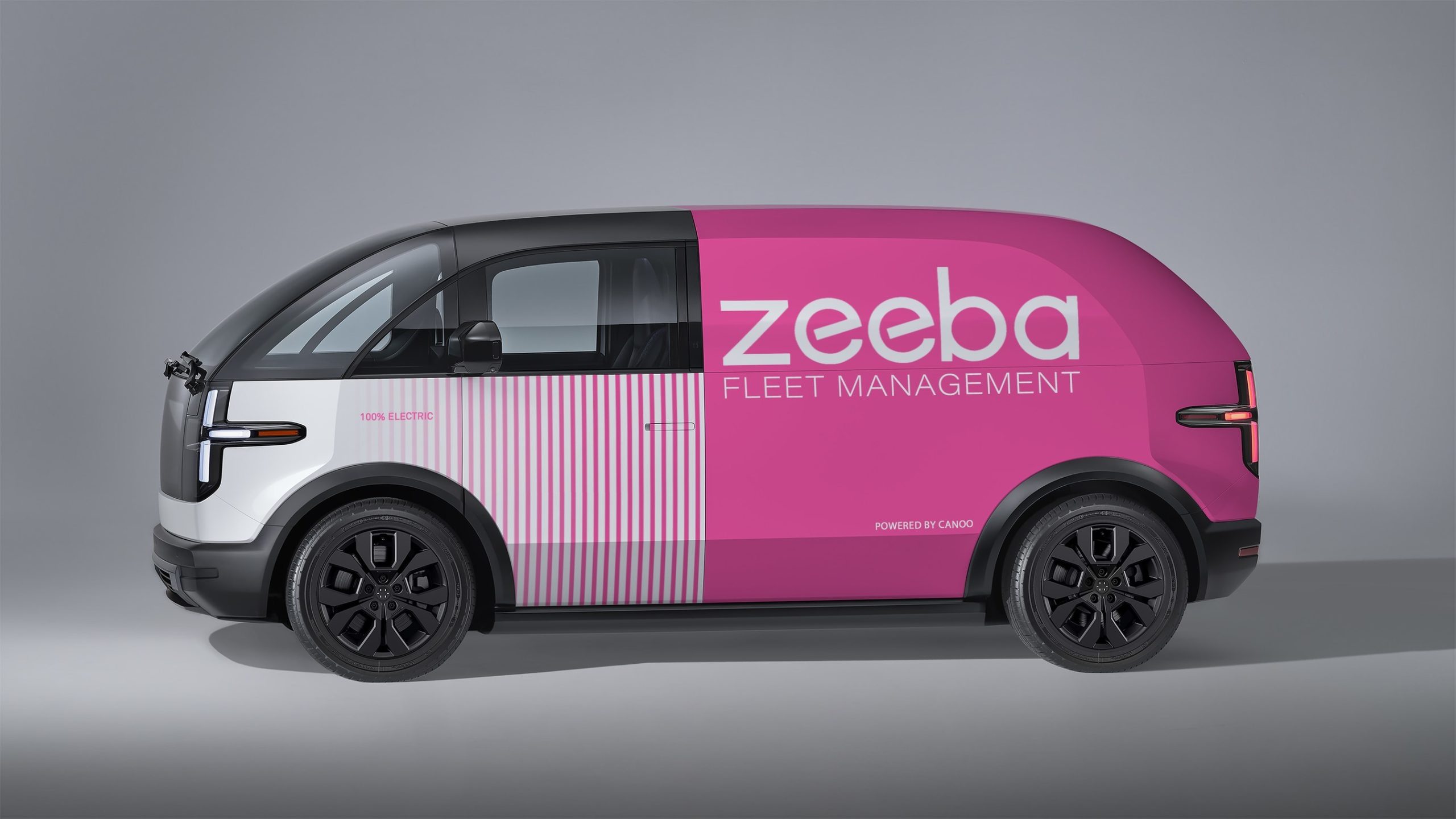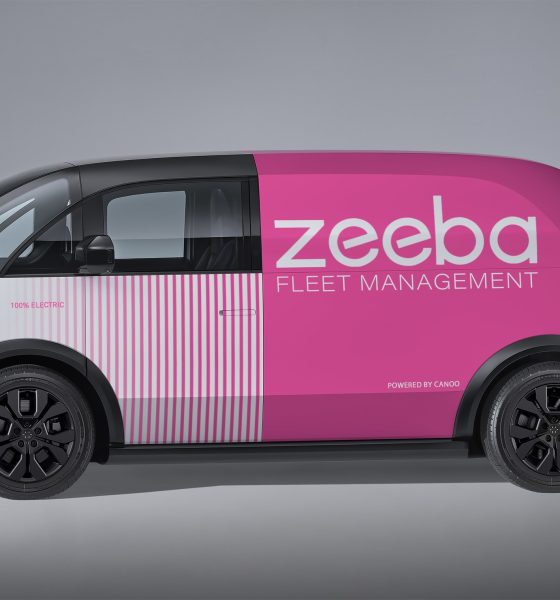

News
Canoo receives another order for their electric delivery vans
Canoo has received an order for over 5000 electric delivery vans from Zeeba, a fleet leasing provider.
Canoo was on the edge of bankruptcy earlier this year as they struggled to get their electric van, the Canoo Lifestyle Vehicle, into production. But they have slowly been able to grow as Walmart, and now Zeeba, have made multi-thousand vehicle orders with the company. But the company isn’t out of the woods yet.
Canoo’s deal with Zeeba announced today will have the automotive brand supply the leasing company with 3,000 vans through 2024 and 5450 vans in total, concluding after the deliveries have been completed.
The Canoo Lifestyle Vehicle and lifestyle delivery vehicle will be a critical part of Zeeba’s plan to be 50% electrified by Q1 2024, but the vans aren’t only chosen for their EV drivetrains. The large 120 cubic feet of storage, the promise of consistent OTA updates and service, and its tight turning circle were all mentioned as influential factors for the purchase.
“We are thrilled to be able to deliver Canoo vehicles to our customers in the near future. We are focused on offering the most advanced fleet solutions and have recognized Canoo’s vehicles as leaders in technology-driven sustainable mobility. We also wanted to secure EV vehicle supply for years to come,” said Kayvon Marashi, Chief Executive Officer for Zeeba Automotive Group, Inc.
But this deal is far more important news for Canoo. “We have a large committed, growing order book, are finalizing our multi-year allocations for 2023 customer deliveries, and will share our manufacturing plan with the broader market shortly,” said Tony Aquila, Chairman & CEO at Canoo. “This order is another milestone validating our product and strategy…”
With corporate orders from Walmart and Zeeba alone totaling nearly 10,000 vehicles, and numerous consumers still waiting for a Canoo Lifestyle Vehicle of their own, the company is likely in a far better financial condition than earlier this year, and their delivery date seems to confirm this as well. The Canoo website states that vehicles will be ready for delivery by the end of this year. However, they have not specified the order in which reservation holders (corporate or otherwise) will receive their vehicles.
Canoo has only one final challenge; follow through. Reservation holders and investors can relax now that the company has stepped away from the brink, but this relief will only be temporary if Canoo can’t start to fulfill these orders. And they should now consider how they will compete with Rivian to supply major brands with electric delivery vehicles.
What do you think of the article? Do you have any comments, questions, or concerns? Shoot me an email at william@teslarati.com. You can also reach me on Twitter @WilliamWritin. If you have news tips, email us at tips@teslarati.com!

News
Tesla starts showing how FSD will change lives in Europe
Local officials tested the system on narrow country roads and were impressed by FSD’s smooth, human-like driving, with some calling the service a game-changer for everyday life in areas that are far from urban centers.

Tesla has launched Europe’s first public shuttle service using Full Self-Driving (Supervised) in the rural Eifelkreis Bitburg-Prüm region of Germany, demonstrating how the technology can restore independence and mobility for people who struggle with limited transport options.
Local officials tested the system on narrow country roads and were impressed by FSD’s smooth, human-like driving, with some calling the service a game-changer for everyday life in areas that are far from urban centers.
Officials see real impact on rural residents
Arzfeld Mayor Johannes Kuhl and District Administrator Andreas Kruppert personally tested the Tesla shuttle service. This allowed them to see just how well FSD navigated winding lanes and rural roads confidently. Kruppert said, “Autonomous driving sounds like science fiction to many, but we simply see here that it works totally well in rural regions too.” Kuhl, for his part, also noted that FSD “feels like a very experienced driver.”
The pilot complements the area’s “Citizen Bus” program, which provides on-demand rides for elderly residents who can no longer drive themselves. Tesla Europe shared a video of a demonstration of the service, highlighting how FSD gives people their freedom back, even in places where public transport is not as prevalent.
What the Ministry for Economic Affairs and Transport says
Rhineland-Palatinate’s Minister Daniela Schmitt supported the project, praising the collaboration that made this “first of its kind in Europe” possible. As per the ministry, the rural rollout for the service shows FSD’s potential beyond major cities, and it delivers tangible benefits like grocery runs, doctor visits, and social connections for isolated residents.
“Reliable and flexible mobility is especially vital in rural areas. With the launch of a shuttle service using self-driving vehicles (FSD supervised) by Tesla in the Eifelkreis Bitburg-Prüm, an innovative pilot project is now getting underway that complements local community bus services. It is the first project of its kind in Europe.
“The result is a real gain for rural mobility: greater accessibility, more flexibility and tangible benefits for everyday life. A strong signal for innovation, cooperation and future-oriented mobility beyond urban centers,” the ministry wrote in a LinkedIn post.
News
Tesla China quietly posts Robotaxi-related job listing
Tesla China is currently seeking a Low Voltage Electrical Engineer to work on circuit board design for the company’s autonomous vehicles.

Tesla has posted a new job listing in Shanghai explicitly tied to its Robotaxi program, fueling speculation that the company is preparing to launch its dedicated autonomous ride-hailing service in China.
As noted in the listing, Tesla China is currently seeking a Low Voltage Electrical Engineer to work on circuit board design for the company’s autonomous vehicles.
Robotaxi-specific role
The listing, which was shared on social media platform X by industry watcher @tslaming, suggested that Tesla China is looking to fill the role urgently. The job listing itself specifically mentions that the person hired for the role will be working on the Low Voltage Hardware team, which would design the circuit boards that would serve as the nervous system of the Robotaxi.
Key tasks for the role, as indicated in the job listing, include collaboration with PCB layout, firmware, mechanical, program management, and validation teams, among other responsibilities. The role is based in Shanghai.
China Robotaxi launch
China represents a massive potential market for robotaxis, with its dense urban centers and supportive policies in select cities. Tesla has limited permission to roll out FSD in the country, though despite this, its vehicles have been hailed as among the best in the market when it comes to autonomous features. So far, at least, it appears that China supports Tesla’s FSD and Robotaxi rollout.
This was hinted at in November, when Tesla brought the Cybercab to the 8th China International Import Expo (CIIE) in Shanghai, marking the first time that the autonomous two-seater was brought to the Asia-Pacific region. The vehicle, despite not having a release date in China, received a significant amount of interest among the event’s attendees.
Elon Musk
Elon Musk and Tesla AI Director share insights after empty driver seat Robotaxi rides
The executives’ unoccupied tests hint at the rapid progress of Tesla’s unsupervised Robotaxi efforts.

Tesla CEO Elon Musk and AI Director Ashok Elluswamy celebrated Christmas Eve by sharing personal experiences with Robotaxi vehicles that had no safety monitor or occupant in the driver’s seat. Musk described the system’s “perfect driving” around Austin, while Elluswamy posted video from the back seat, calling it “an amazing experience.”
The executives’ unoccupied tests hint at the rapid progress of Tesla’s unsupervised Robotaxi efforts.
Elon and Ashok’s firsthand Robotaxi insights
Prior to Musk and the Tesla AI Director’s posts, sightings of unmanned Teslas navigating public roads were widely shared on social media. One such vehicle was spotted in Austin, Texas, which Elon Musk acknowleged by stating that “Testing is underway with no occupants in the car.”
Based on his Christmas Eve post, Musk seemed to have tested an unmanned Tesla himself. “A Tesla with no safety monitor in the car and me sitting in the passenger seat took me all around Austin on Sunday with perfect driving,” Musk wrote in his post.
Elluswamy responded with a 2-minute video showing himself in the rear of an unmanned Tesla. The video featured the vehicle’s empty front seats, as well as its smooth handling through real-world traffic. He captioned his video with the words, “It’s an amazing experience!”
Towards Unsupervised operations
During an xAI Hackathon earlier this month, Elon Musk mentioned that Tesla owed be removing Safety Monitors from its Robotaxis in Austin in just three weeks. “Unsupervised is pretty much solved at this point. So there will be Tesla Robotaxis operating in Austin with no one in them. Not even anyone in the passenger seat in about three weeks,” he said. Musk echoed similar estimates at the 2025 Annual Shareholder Meeting and the Q3 2025 earnings call.
Considering the insights that were posted Musk and Elluswamy, it does appear that Tesla is working hard towards operating its Robotaxis with no safety monitors. This is quite impressive considering that the service was launched just earlier this year.








